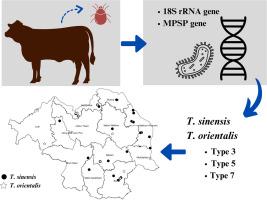Detection of Theileria in cattle ticks (Rhipicephalus microplus) (Canestrini, 1888) in upper-northeastern Thailand
IF 2.1
3区 医学
Q2 PARASITOLOGY
引用次数: 0
Abstract
Theileria parasites were investigated from cattle ticks (Rhipicephalus microplus (Canestrini, 1888)) collected in 12 provinces in upper-northeastern Thailand based on the sequences of 18S rRNA and MPSP gene. Polymerase chain reactions (PCRs) and sequencing specific regions for the 18S rRNA gene revealed two species of Theileria pathogens; T. orientalis (n = 42) and T. sinensis (n = 31) with 94.50−100 % identity. In the provinces of upper-northeastern Thailand, the nucleotide diversity of Theileria's 18S rRNA for T. sinensis and T. orientalis were 0 % and 1.3 %. respectively. The MPSP gene was used to categorize the T. orientalis genotypes. The sequences were compared with those available in the public database (GenBank) for species identification. Phylogenetic trees of Theileria were constructed from the MPSP gene sequences of our amplicons and those available in GenBank using maximum-likelihood and neighbor-joining analyses. The results revealed three identified genotypes: type 3, 5, and 7. Although the main carriers of T. orientalis are ticks in the genus Haemaphysalis, T. orientalis was the most frequently found in R. microplus in upper-northeastern Thailand. Theileria was frequent in Nong Khai, Mukdahan, and Loei, three Thai provinces that bordered the Lao PDR close to the Mekong River. Epidemiological surveys and control strategies in this region should be considered.

在泰国东北部上游地区的牛虱(Rhipicephalus microplus)(Canestrini,1888 年)中检测到 Theileria。
根据 18S rRNA 和 MPSP 基因的序列,研究了从泰国东北部上游 12 个府采集的牛虱(Rhipicephalus microplus (Canestrini, 1888))中的寄生虫。聚合酶链式反应(PCR)和 18S rRNA 基因特定区域的测序结果显示,病原菌有两个物种:T. orientalis(n=42)和 T. sinensis(n=31),其同一性为 94.50%-100%。在泰国上东北部各府,T. sinensis 和 T. orientalis 的丝核菌 18S rRNA 核苷酸多样性分别为 0% 和 1.3%。利用 MPSP 基因对东方蓟马的基因型进行了分类。将序列与公共数据库(GenBank)中的序列进行比较,以确定物种。使用最大似然法和邻接分析法,根据我们的扩增子的 MPSP 基因序列和 GenBank 中的序列构建了东方蓟马的系统发生树。结果发现了三种已确定的基因型:3 型、5 型和 7 型。虽然 T. orientalis 的主要携带者是 Haemaphysalis 属的蜱虫,但在泰国上东北部的 R. microplus 中最常发现 T. orientalis。在靠近湄公河、与老挝人民民主共和国接壤的泰国廊开府、木爹罕府和乐毅府,东方蜱属螨虫十分常见。应考虑在这一地区开展流行病学调查并制定控制策略。
本文章由计算机程序翻译,如有差异,请以英文原文为准。
求助全文
约1分钟内获得全文
求助全文
来源期刊

Acta tropica
医学-寄生虫学
CiteScore
5.40
自引率
11.10%
发文量
383
审稿时长
37 days
期刊介绍:
Acta Tropica, is an international journal on infectious diseases that covers public health sciences and biomedical research with particular emphasis on topics relevant to human and animal health in the tropics and the subtropics.
 求助内容:
求助内容: 应助结果提醒方式:
应助结果提醒方式:


